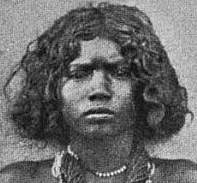Irula people
|
A group of Irula men photographed (1871-72). | |
| Total population | |
|---|---|
| 25,000 | |
| Regions with significant populations | |
|
| |
| Languages | |
| Irula language | |
| Related ethnic groups | |
| Soliga, Tamil, Yerukala |
Irula is an ethnic group of India. They inhabit the area of the Nilgiri mountains, in the states of Tamil Nadu and Kerala, India.[1] A scheduled tribe, their population in this region is estimated at 25,000 people.[2][3] People of Irula ethnicity are called Irular, and speak Irula, which belongs to the Dravidian family.
Etymology
Irular means "dark people" in Tamil and Malayalam, from the root word irul, meaning "darkness", in reference to their dark skin complexion.[4][5]
Anthropology

Early 20th century anthropological literature classified the Irular under the Negrito ethnic group.[3][6]
Culture
Unlike the Negrito tribes in the Andaman Islands who have retained their language, Irular speak the Irula language, a Dravidian language that is closely related to Tamil, Yerukala, Sholaga and other Tamil languages.[7]
Distribution
Irular live in two south Indian states – Tamil Nadu and Kerala. In Tamil Nadu they live in the Nilgiris, Coimbatore and Erode districts. In Kerala they live in the Palakkad district and Attapady and Walayar panchayats.
They live in four taluks in Coimbatore district, namely Coimbatore South, Coimbatore North, Avinashi and Madathukulam. The Coimbatore district houses 4254 Irulas in 40 settlements comprising 139 villages. Nearly 100 Vettakada Irula settlements are found in the forest areas or in the deep mountainous jungles. There are 4 tribal settlements in the Siruvani Hills comprising 14 villages.[8]
The Census of Kerala identified 756 Irulan individuals from 189 families, who lived in 9 settlements covering .23 km² in the state.[9]
Economy
Traditionally, the main occupation of the Irulas has been snake and rat catching. They also work as labourers (coolies) in the fields of the landlords during the sowing and harvesting seasons or in the rice mills. Fishing is also a major occupation.
Rats destroy a quarter of the grain grown on Tamil Nadu-area farms annually. To combat this pest, Irula men use a traditional earthen pot fumigation method. Smoke is blown through their mouths, which leads to severe respiratory and heart problems.[2]
See also
- Irula language
- Thondai Nadu
References
- ↑ Perialwar, R. (1979), Phonology of Irula with Vocabulary, Annamalai University
- 1 2 World Bank grant to improve standard of living for rat-catchers
- 1 2 Irula Project Proposal and site report
- ↑ "Irular in India". Joshua Project. Frontier Ventures. Retrieved 2016-06-05.
- ↑ Gnanamoorthy, K. "Present Situation of Irular - A Primitive Tribe" (PDF). IOSR Journal of Economics and Finance. 6 (1): 46. ISSN 2321-5933.
- ↑ Giving Irulas their due
- ↑ Keystone Foundation (2006) "People of the Nilgiri Biosphere Reserve" retrieved 3/26/2007(NBR)"People of the Nilgiri Biosphere Reserve"
- ↑ Dr. Pauline Das, The Irula Language and Literature
- ↑ "Tribal Settlements in the Forests of Kerala". Kerala Department of Forests and Wildlife. 2009-09-18. Retrieved 2016-06-19.
External links
- "Building a better Rat Trap: Technological Innovation, Human Capital and the Irula" - Economic Research Paper about the Irula
- "Irular: The Seekers of light" - Article by G. S. Unnikrishnan Nair in Kerala Calling March 2014
